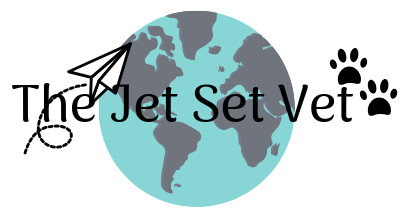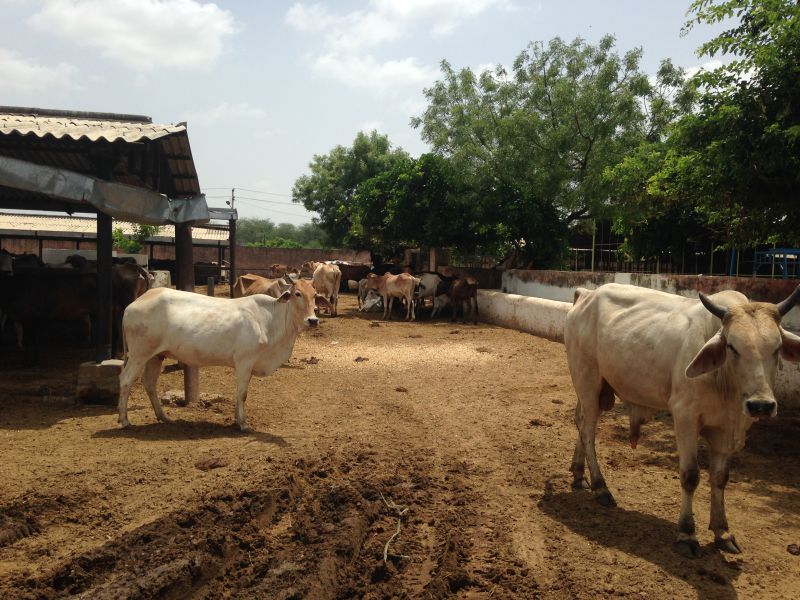On one of our quieter days we took the opportunity to tag along with the rescue team on a cow release. Now I feel this phrase makes the cows sound like wild animals which although to us may seem a little silly, it is a lot more fitting to describe the cows here as some of them really do have a bit of a wild attitude! We took a large bull with a dislocated shoulder to the government run?!? Cow sanctuary for him to live out the rest of his days alongside 7,000 other cows….. I have to say this is a weird concept for a Brit who’s used to farming and eating cattle. Not that I don’t like cows, I am a big fan of the bovine in fact…. But in the UK cattle are not animals usually considered in need of saving! It was a 2 hour drive in the non-air-conditioned rescue truck with the four of us ( me, Beth and two fellow compounders) wedged in (largely down to our two western girl derrieres!) quite uncomfortably in the sticky heat.
We passed a number of little villages on the way to the sanctuary. The villages in India are a far cry from what we would picture in the UK; with lush greenery, cows in fields and quaint country cottages nestled in the peace and quiet of a little valley. Indian villages are loud, dry, dusty, colourful, ramshackled and are accompanied by a distinct smell which can only be described as a mixture of petrol, animal (and possibly human waste), cooking spices and dirt. People are always milling and shouting, the women in brightly coloured Saris and the men in western shirts and Jeans. The women always seemed to be busy; bustling about bathing children, tending to animals, carrying great loads on their heads, working in the fields or on the streets. The men (forgive my rather sexist observation but I can’t lie about what I saw) always seemed to be lounging about in one way or another; some sleeping in the side of the road, others squatting talking to friends or just loitering without intention with a glazed expression, completely switched off from the chaos around them. There was rubbish everywhere, piled high at the sides of the road, which the animals and people pick through it to find a tasty morsel or a stray bit of cash. Pigs, dogs, cows and goats wandered around the streets in an almost human manner, and there seemed to always be a young boy dragging a reluctant buffalo through the streets. At some point during the afternoon, a brightly painted tractor would park up by the roadside blasting out Indian songs which would summon people to drop what they were doing and go and dance for a while. We never did get to the bottom of these “party tractors” but they seemed to be an integral part of every village. The houses were mud or straw huts, usually with corrugated iron or hand woven thatched roofs which bowed under the weight of themselves or sat at a jaunty angle, these houses were clearly not made to last but were made with a simplicity that could easily be re-constructed should the next monsoon shower cause their demise. At the forefront of everything, right on the roadside were the market stalls selling their wares. These little shops plastered with brightly coloured posters which had no correlation to their merchandise sold an array of bizarre things cigarettes, bottles of pop and a packeted herby smelling substance called paann (a mixture of herbs and seeds) which the Indian men chew to freshen their breath and made them spit a horrendous orangey brown colour and stained their teeth the same hideous shade.

We drove through the gates of Guyshala (the cow sanctuary) to be met by a huge complex filled with rows and rows of sheds and gated compounds where there were literally cows as far as the eye could see. All different breeds, ages, genders all lazily chewing their cud in the shade or nosing about in the mud. Some were hobbling on awkwardly angled limbs while others were completely blind yet still managing to navigate the other animals without a worry. The stocking density would have definitely been an issue had we been in the UK but from what we could see the cows really were at peace and did not look at all discontented by the huge number of neighbours they had. Upon further thought a place like Guyshala probably did seem like a sanctuary to many of these cows who’d been left to fend for themselves in the streets, grazing on waste and living in constant peril from road traffic accidents. At the sanctuary they had shelter, they were fed like kings compared to the garbage buffet they’d become used to, and they were safe. I feel the cows, like the people of India saw the joy in the little things.

We let our boy go and then went for a wander round “cow heaven.” The sick cows were housed in large airy barns and a lot of thought and TLC seemed to be put into them; the ones that were weak and unable to stand were propped up with sand bags so they could ruminate with their own food and water source to keep them going. Their wounds were meticulously cared for and the ground was soft and clean. However that did not unfortunately draw attention away from the fact that some of the cows in that building needed euthanasia and here they had a strict no kill policy…..
We left our boy who had become quite the subject of interest by the older residents and seemed to be enjoying the attention he was getting from the “ladies.” We headed back out on the road and stopped for a little snack of samosas and of course, chai on the way back. It was during this pit-stop that we experienced yet another Indian road novelty, a tractor doing a wheely!! I honestly didn’t even think that was possible but apparently, in India it is! Unfortunately, we were both so baffled by the scene playing out in front of us, neither of us were quick enough to reach for our cameras to document this bizarre occurrence.
When we arrived back at Help in Suffering one of the vets was just about to perform a lump removal on a dog so we poked our heads in to watch. As I had done surgery that morning, Beth scrubbed in to assist with the procedure. None of us had operated with this particular vet before, but from this experience we found out that he was quite the diva when operating. He barked incoherent orders at Beth and blamed her for things that went wrong, I sniggered in the background as I observed Beth’s jaw clench and her eyebrows raise higher and higher into her hairline the longer this went on. Initially she held her tongue and responded to his arrogance with bitter chunterings under her breath which eventually escalated to a few very pointed and venomous comments thrown in his direction. Again, in the UK this approach would have probably gotten you drop-kicked out of the vets practice, quicker than you could say cat castrate, but here the vet was caught quite off guard, looked rather flustered and was much more polite thereafter. There was a definite lack of respect amongst the vets we spent time with for those they considered of lower rank , like the nurses which is an attitude at home everyone has really tried to crack down on to change. At university and in practice we are taught to value all team members as each has a role that helps you in one way or another, especially vet nurses, they are a god sent in the UK and certainly worthy of respect no matter how good or experienced the surgeon thinks he or she is. It is definitely a lesson the Indian vets here could do with learning!

That evening as the weather was so glorious we went for a swim. We were the only ones in the pool when we got there which was glorious but slowly people emerged from their hotel rooms, not to swim I might add, just to spectate. It’s so nice that we provide them with such entertainment! I mean who wouldn’t want to watch two white girls swimming?





